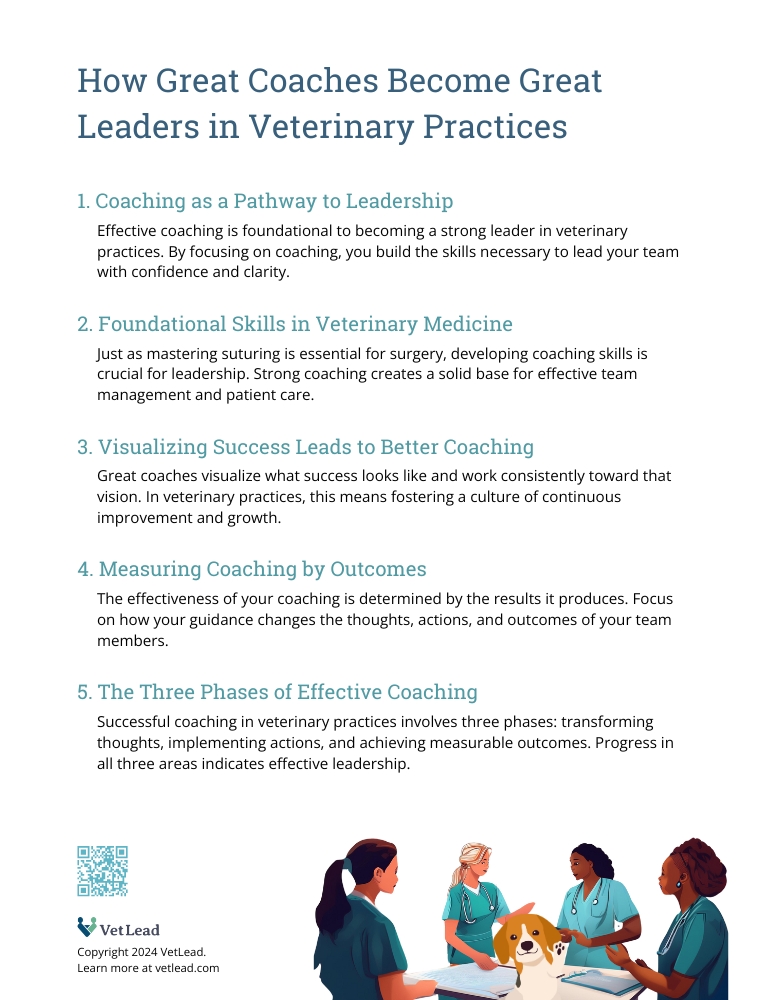If you are a great coach, you are well on your way to being a great leader in the veterinary field. Yes, there are other things you need to do, and yes, becoming a great coach requires a specific set of skills, but if you can excel at coaching, you will build a strong foundation that enhances your ability to lead more effectively in your practice or clinic.
Foundational Skills in Veterinary Leadership
Consider this analogy: If you want to be a skilled veterinary surgeon but have poor suturing techniques, your success is limited. Mastery of suturing is foundational to surgical excellence, just as effective coaching is foundational to leadership in the veterinary profession. Just like in a veterinary surgery, where precision and practice are crucial, developing coaching skills requires a clear vision of what “good” looks like and the dedication to practice until you achieve it.
Visualizing Success: The First Step to Effective Coaching
To improve, you need to know what success looks like and have a clear mental image of it. If you aim to perfect your suturing technique, you picture smooth, consistent stitches that promote healing without complications. Similarly, in coaching, you need a clear picture of effective coaching interactions that foster growth and development in your team members.

What Does Good Coaching Look Like in Veterinary Practice?
When it comes to coaching, many veterinary professionals may not yet have a clear picture of what effective coaching entails. You might think it involves giving critical feedback, correcting mistakes, or offering advice on improving clinical practices. While these elements can be part of coaching, they alone do not define good coaching.
Measuring Coaching by Outcomes
It’s easy to assess coaching by the effort you put in, much like evaluating a treatment plan based on the medications prescribed rather than the patient’s recovery. However, true coaching effectiveness is measured by the impact it has on the person you’re coaching. In veterinary practices, the outcome matters. If your coaching doesn’t lead to better performance or improved skills, it hasn’t been successful.
Coaching through Observation: Thoughts, Actions, and Outcomes
Effective coaching in the veterinary field can be measured by three key changes you observe in your team: changes in their thoughts, actions, and outcomes.

Overcoming the “It’s Not My Fault” Trap
It’s tempting to say, “My coaching was good, but they just didn’t apply it.” In veterinary settings, this is equivalent to saying, “The treatment plan was good, but the pet owner didn’t follow through.” Effective coaches, like skilled veterinarians, don’t just prescribe a plan—they ensure their advice is actionable and achievable for those they are coaching.
The Three Phases of Effective Veterinary Coaching
To enhance your coaching, focus on these three phases:
- 1Thought Transformation: Did your coaching help them think differently about patient care, clinic operations, or professional growth?
- 2Action Implementation: Did your coaching lead to tangible steps, such as adopting new procedures or improving client interactions?
- 3Outcome Achievement: Did your coaching result in measurable improvements, such as higher patient recovery rates or more streamlined workflows?
When you observe progress in all three areas, you’re not just a coach—you’re a leader shaping the future of veterinary medicine.

Download this Accompanying PDF Now
Share it with leaders and teams. No email address required.
What have you found that helps you coach your team effectively? Share your thoughts in the comments below.
